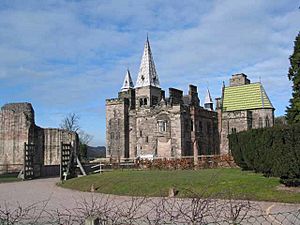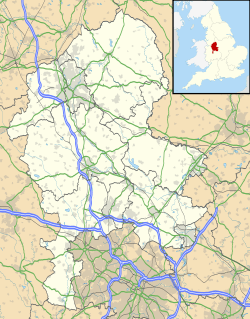Alton Castle facts for kids
Quick facts for kids Alton Castle |
|
|---|---|
| Alton, Staffordshire | |
 |
|
| Coordinates | 52°58′47″N 1°53′28″W / 52.9798°N 1.8912°W |
| Type | Masonry castle |
| Site history | |
| Built | 12th century; present building: mid-19th-century. |
| Built by | Bertram de Verdun; present castle built by John Talbot, 16th Earl of Shrewsbury |
Alton Castle is a cool castle that looks like it's from a fairy tale! It's built in a style called Gothic-revival. You can find it on a hill above the Churnet Valley in the village of Alton, England.
This spot has been important for a very long time. People have built forts here since Saxon times! The first stone castle was built in the 1100s. The castle you see now was built in the mid-1800s. It was created by John Talbot, 16th Earl of Shrewsbury, who also owned the famous Alton Towers nearby. Since 1967, Alton Castle has been a special protected building, called a Grade I listed building. It's also a scheduled ancient monument, which means it's an important historical site.
Contents
History of Alton Castle
Early Beginnings
Alton Castle was first built from stone in the 1100s. It was founded by a person named Bertram III de Verdun. The castle was placed on a rocky cliff overlooking the River Churnet. But even before that, people had built wooden forts on this spot since Saxon times. In old papers, the castle is sometimes called Alton, Alverton, or Aulton.
The original 12th-century castle was changed a lot in the 1400s. Later, it was damaged during the English Civil War. This was a big war in England in the 1600s.
The Shrewsbury Family and Rebuilding
From 1442, the castle belonged to the Earls of Shrewsbury. These powerful nobles later made their home at Alton Towers in the early 1800s. By the mid-1800s, Alton Castle was mostly a ruin.
Then, John Talbot, 16th Earl of Shrewsbury, decided to rebuild it. He hired a famous Catholic architect named Augustus Pugin. Pugin was already working for the Earl at Alton Towers. He designed a new Gothic-style castle. It was meant to look like a medieval castle built by crusaders in Germany!
Most of the old 12th-century ruins were taken down to make space for the new building. The Earl also asked Pugin to improve the area around the castle. They built a "replica of a medieval hospital, a guildhall and presbytery." These buildings were named after St. John the Baptist. They worked as a church and a hospital for the poor people in the area. The church also became a school for local children who didn't have much money.
Why Was It Rebuilt?
It's not totally clear why the 16th Earl rebuilt the castle. Maybe it was for his cousin, Bertram Talbot, who later became the 17th Earl of Shrewsbury. Or perhaps it was meant to be a special home for the Earl's wife if he passed away before her. This kind of home is called a Dower House.
Near the end of the castle's construction, the Earl thought about making it a home for priests. But Pugin, the architect, really didn't like that idea!
A New Purpose
In 1855, a group of nuns called the Sisters of Mercy took over the site. The presbytery building became their convent. The castle stayed a private home until 1919. That year, the Sisters of Mercy bought the castle for £3,500. They wanted to make their boarding school bigger.
The school closed in 1989, and the castle was empty for a while.
Alton Castle Today
In 1996, the Archdiocese of Birmingham (a Catholic Church group) turned Alton Castle into a Catholic Youth Retreat Centre.
Now, over 8,000 children visit the castle every year! Most come with their schools. Other groups, like youth clubs and charities that help children with disabilities, also visit. Many of these children come from city areas where life can be tough.
During their stay, the children get to do lots of fun activities. These include mountain biking, trekking (long walks), archery, rock climbing, and even survival skills! It's a great place for kids to learn and have adventures.


